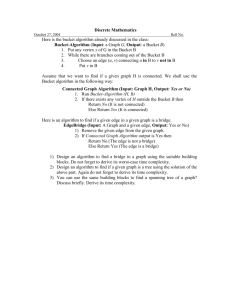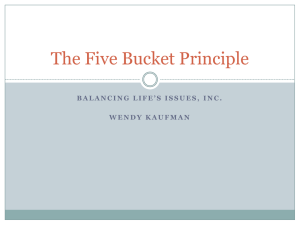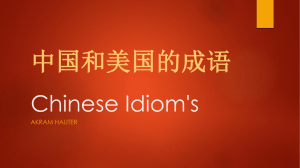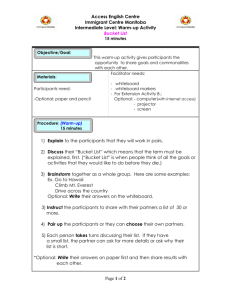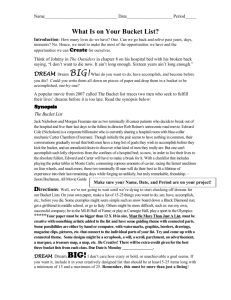E:\My Documents\snc1d\bio\Nutrient Cycles.wpd
advertisement
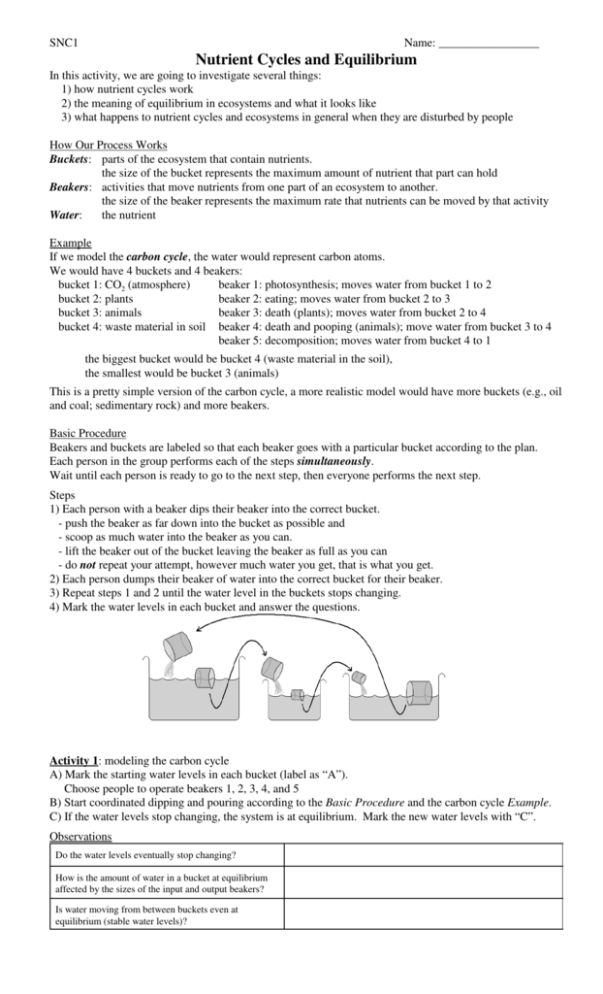
SNC1 Name: _________________ Nutrient Cycles and Equilibrium In this activity, we are going to investigate several things: 1) how nutrient cycles work 2) the meaning of equilibrium in ecosystems and what it looks like 3) what happens to nutrient cycles and ecosystems in general when they are disturbed by people How Our Process Works Buckets: parts of the ecosystem that contain nutrients. the size of the bucket represents the maximum amount of nutrient that part can hold Beakers: activities that move nutrients from one part of an ecosystem to another. the size of the beaker represents the maximum rate that nutrients can be moved by that activity Water: the nutrient Example If we model the carbon cycle, the water would represent carbon atoms. We would have 4 buckets and 4 beakers: bucket 1: CO2 (atmosphere) beaker 1: photosynthesis; moves water from bucket 1 to 2 bucket 2: plants beaker 2: eating; moves water from bucket 2 to 3 bucket 3: animals beaker 3: death (plants); moves water from bucket 2 to 4 bucket 4: waste material in soil beaker 4: death and pooping (animals); move water from bucket 3 to 4 beaker 5: decomposition; moves water from bucket 4 to 1 the biggest bucket would be bucket 4 (waste material in the soil), the smallest would be bucket 3 (animals) This is a pretty simple version of the carbon cycle, a more realistic model would have more buckets (e.g., oil and coal; sedimentary rock) and more beakers. Basic Procedure Beakers and buckets are labeled so that each beaker goes with a particular bucket according to the plan. Each person in the group performs each of the steps simultaneously. Wait until each person is ready to go to the next step, then everyone performs the next step. Steps 1) Each person with a beaker dips their beaker into the correct bucket. - push the beaker as far down into the bucket as possible and - scoop as much water into the beaker as you can. - lift the beaker out of the bucket leaving the beaker as full as you can - do not repeat your attempt, however much water you get, that is what you get. 2) Each person dumps their beaker of water into the correct bucket for their beaker. 3) Repeat steps 1 and 2 until the water level in the buckets stops changing. 4) Mark the water levels in each bucket and answer the questions. Activity 1: modeling the carbon cycle A) Mark the starting water levels in each bucket (label as “A”). Choose people to operate beakers 1, 2, 3, 4, and 5 B) Start coordinated dipping and pouring according to the Basic Procedure and the carbon cycle Example. C) If the water levels stop changing, the system is at equilibrium. Mark the new water levels with “C”. Observations Do the water levels eventually stop changing? How is the amount of water in a bucket at equilibrium affected by the sizes of the input and output beakers? Is water moving from between buckets even at equilibrium (stable water levels)? As the water level in a bucket drops, can you fill up the beaker that is taking water out of it? Is this realistic? For example, if the plant population were to decrease (the water level in bucket 2 drops), would each animal be able to get as much to eat? D) Model the effects of polluting one part of the ecosystem: the atmosphere. Add enough food colouring to make the water in bucket 1 noticeably coloured. E) Continue coordinated dipping and pouring. Observations Does the “pollution” stay in the “atmosphere”. F) Model the effects of the burning of trees and other plants as fuel by humans, which turns plants back into CO2 in the atmosphere. Add beaker 6 to the process. It will move water from bucket 2 to bucket 1. G) Continue coordinated dipping and pouring. H) If water levels stop changing again, mark the new water levels with “H”. Observations Do water levels start changing when beaker 6 is used? Do the water levels eventually stop changing again? What happens to the amount of water in bucket 1 (the amount of CO2 in the atmosphere)? What happens to the amount of water in bucket 2 (the biomass of plants in the ecosystem)? Beaker 6 did not directly affect buckets 3 (animals) or 4 (the soil). Did their water levels change anyway? If you change any part of a cycle in an ecosystem, will all the other parts get affected as well? I) Put beaker 6 away and return the water levels to what they were in step “C”. J) Model the effect of human use of fossil fuels (burning of oil and coal). These activities also add CO2 to the atmosphere. To model this, add enough water to bucket 1 to raise its level by 3 cm. Mark this new level with “J” K) Continue coordinated dipping and pouring. L) If water levels stop changing again, mark the new water levels with “L”. Observations Did all of the “carbon” added to the “atmosphere” stay there? When the ecosystem is back in equilibrium, is the amount of “carbon” in the “atmosphere” more or less that what is was before the oil and coal were burned? The Nitrogen Cycle Copy the nitrogen cycle from the Nutrient Cycle work sheet. It is somewhat simplified compared to the cycle diagram on page 16 in the text book. In particular, the worksheet version combines soil and ocean (including lakes and rivers). Design a bucket and beaker simulation of this cycle. 1) How many buckets would you need? 2) Which of the cycle components would have the biggest and smallest buckets? 3) a) Given what the worksheet and text book have to say about nitrogen fixation, what size beaker would be appropriate for this process? b) What does this suggest about how much water would be present in the “soil” bucket when the cycle achieves equilibrium? c) What effect will this have on the growth potential of plants and animals? 4) a)What do farmers do to solve the problem in question 3? b) How would you model this in a simulation? c) What effect would this have on the amount of water in the “waste” bucket? 5) Which element suppresses the process of denitrification?



